Please first login if you wish to upgrade to use this programme! Register Now
- Exhaust Time FlowArea Programme
- Example - AM6 50cc Cylinder
- Example - Yamaha TA125 Production Racer Cylinder
- Example - Yamaha TZ250 Production Racer Cylinder
- Example - KTM 65 SX Motocross Cylinder
- Example - Puch Maxi 50cc Cylinder
Exhaust Time FlowArea Programme
This programmme calculates the specific time-flowarea and specific blowdown time-flowarea for the exhaust port of an engine, based on actual flowbench data. From this information the programme calculates the potential power capability of the engine. If you require an increase in power from your engine, you can quickly ascertain what modification will give you the required increase.
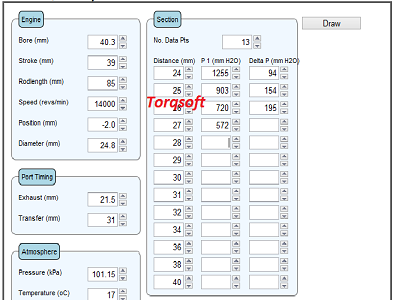
Time-Area calculated by the traditional method of using the exhaust port actual dimensions is a fantastic tool. However, there are engine cylinders that just do not flow as well as the calculated time-area would suggest resulting in poor performance and often a lot of wasted development effort. Using the Torqsoft time-flowarea programme will actually give more reliable power predictions numbers.
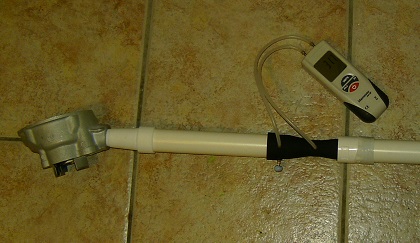
The heart of the equipment required for flow testing is the venturi flow meter, the black item in the above photo.
Purchase V15 Venturi Flow Meter - V15 Venturi
Purchase V18 Venturi Flow Meter - V18 Venturi
Purchase V20 Venturi Flow Meter - V20 Venturi
The V15 is most suitable for cylinders with exhaust port diameters less than 23 mm, the V18 for exhaust port diameters less than 27 mm and the V20 is suitable for port diameters less than 33 mm.
A larger Venturi Flow Meter - V27 is suitable for cylinders with exhaust port diameters between 30 and 44 mm, and is shown below.
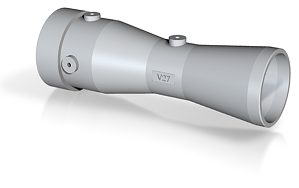
Top
AM6 50cc Cylinder
The image below shows the engine details entered for this engine fitted with an after market high performance 50cc cylinder. These include the Bore, Stroke, Rodlength, Peak Power Speed and Exhaust Port Diameter. The piston distance ( at TDC ) relative to the top of the cylinder is also entered. Notice that in this example the value is -2.0, with the minus sign indicating that the piston timing edge is below the top of the cylinder at TDC. Note that if the timing edge of the piston protrudes above the top of the cylinder at TDC then the number will have a positive value.
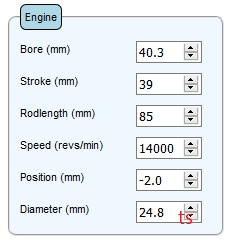
Next the distance from the top of the cylinder to the opening of the exhaust and transfer ports is entered as shown below
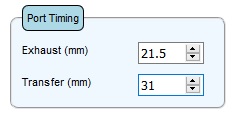
Next the data from the actual flow tests is entered. The image below shows the measured flow data for 3 piston positions. The distance from the top of the cylinder to the timing edge of the piston is entered in the first column. The measured pressure differential across the venturi ( measured in units of mm of H2O ) is entered in column 4. The measured pressure at the inlet to the venturi is entered in column 3.
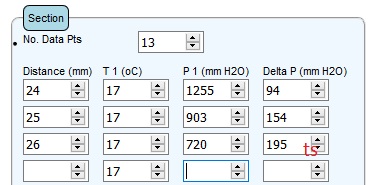
The image below shows the computed output for an after market high performance 50cc cylinder for a Minarelli AM6 engine. The first line shows the calculated port timings - exhaust and transfer. The final two lines show the potential power output based on the calculated specific time-flowarea, both blowdown and total. This engine dyno tested at 15.6 bhp at the rear sprocket - equivalent to 16.95 bhp at the crank - and correlates closely with the computed specific time-flowarea potential.

Once the first calculation is carried out, it is very easy to carry out some what if calculations. For example, we can raise the cylinder by adjusting the piston position parameter. Shown below is the computed output for the same cylinder raised by 0.5 mm. It can be seen that the potential power has risen from 17.52 bhp to 18.21 bhp, an increase of 0.7 bhp.

Top
Yamaha TA125 Production Road Racer Cylinder
The image below shows the exhaust port of a Yamaha TA125 cylinder - a twin cylinder, piston ported inlet, air-cooled production road racer produced in the 1970's. The engine has a bore and stroke of 42.00 mm.
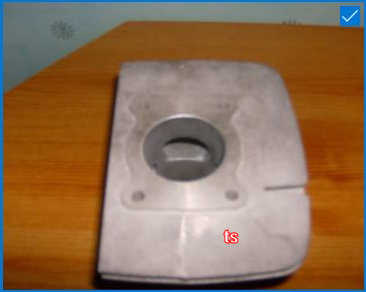
The image below shows the exhaust port of a Yamaha TA125 cylinder being flow tested using a Torqsoft Venturi Flowmeter. The raw flow data collected from the 15 piston positions tested were input into Torqsoft Flow-Time-Area programme. The computed output indicated that the TA125 cylinder exhaust port flows very efficiently and has a high potential power output.
The programme also allowed us to "lift" and "lower" the cylinder in order to optimise both the transfer and exhaust timings for maximum power.
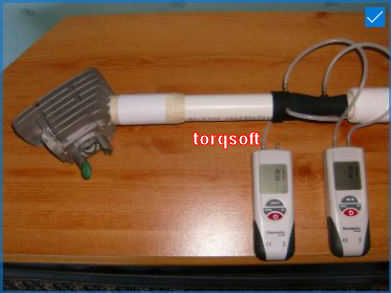
Top
Yamaha TZ250 Production Road Racer Cylinder
The image below shows the exhaust port of a Yamaha TZ250 cylinder - a v-twin cylinder, reed valve inlet, water-cooled production road racer produced in the 1990's. The engine has a bore of 56.00 mm and a stroke of 50.6 mm.
Top
KTM 65 SX Motocross Cylinder
The image below shows the exhaust port of a KTM 65 SX cylinder - a single cylinder, crankcase reed inlet, water-cooled production motocrosser - being flow tested. The engine has a bore and stroke of 45.00 mm and 40.8 mm respectively.
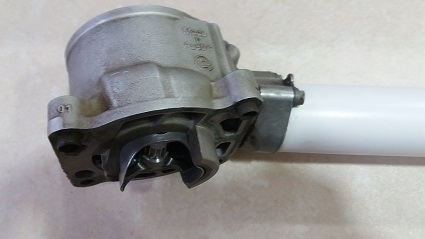
Flow testing with the powervalve both raised and lowered has allowed us to gain a significant power upgrade in this engine.
Top
Puch Maxi 50cc Cylinder
The image below shows the exhaust port of a Puch Maxi 50cc cylinder - a single cylinder, piston ported inlet, air cooled moped engine - being flow tested. The engine has a bore and stroke of 38.00 mm and 42.00 mm respectively. This particular cylinder has 1 exhaust port, 2 transfer ports and 1 inlet port.
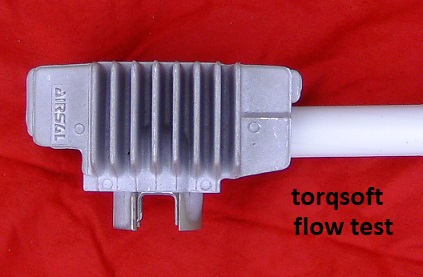
It is evident from the calculated results shown below that the exhaust port is in a quite a high state of tune for a moped cylinder. The potential power capability for the exhaust port is in the region of 10.5 bhp at the crank. Flow testing of the transfer ports were to reveal a power capability considerably less than the exhaust port.
The flow testing of this airsal puch 50cc showed that this cylinder has unmatched power capability between the ports. Using the results from the flow test for guidance, we were able to improve the power output of this cylinder considerably.

Top